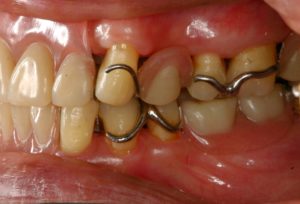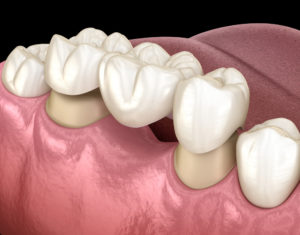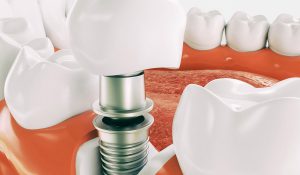What are My Tooth Replacement Options?
 Millions of Americans are missing one or more teeth. Missing even a single tooth affects your ability to chew, and obviously, missing a front tooth creates a cosmetic problem. At Designer Smiles, we are experts at tooth replacement, and we offer multiple options to meet a variety of needs.
Millions of Americans are missing one or more teeth. Missing even a single tooth affects your ability to chew, and obviously, missing a front tooth creates a cosmetic problem. At Designer Smiles, we are experts at tooth replacement, and we offer multiple options to meet a variety of needs.
While the exact tooth replacement can vary relatively widely, we can break the options into a few categories.
- Removable Tooth Replacement Options
- Fixed (or non-removable) Tooth Replacement Options
- Supported by Neighboring Teeth
- Supported by Dental Implants
Each option has advantages over the others, and each has certain disadvantages that we will discuss further.
Removable Tooth Replacement Options
In dentistry, we tend to group removable tooth replacement options under the name “partials”. This term is short for the technical term removable partial denture or RPD. This helps us distinguish it from the removable dental appliance that replaces all of the teeth, commonly referred to as simply “dentures”. A denture is technically a removable full denture. For our considerations here, we will be talking about partials only because we are discussing the replacement options for one or just a few teeth, and not all of the teeth.
A partial, or RPD, is a dental appliance that replaces missing teeth with plastic or porcelain “pontics” (fake teeth). The appliance itself contains a framework or base that rests on the gums of the missing teeth and attaches to neighboring teeth with metal or plastic clasps. Partials do require the support of neighboring teeth to provide the ability to chew.
Advantages of Partials
The biggest advantage of partials is their low cost. They are, by far, the most affordable way to replace missing teeth.
Partials have the advantage of replacing multiple teeth within a single appliance, without increasing the cost.
Partials do not take long to make. You will have your appliance and “new teeth” within several weeks, which include multiple appointments for molds, scans and fittings.
Disadvantages of Partials
 Unfortunately, partials have the worst cosmetic appearance. Often the clasps are visible, or the fake teeth do not blend in seamlessly with the natural teeth.
Unfortunately, partials have the worst cosmetic appearance. Often the clasps are visible, or the fake teeth do not blend in seamlessly with the natural teeth.
Discomfort and inability to chew well are common complaints with removable partials.
Damage to the supporting teeth, including cracking and gum recession, is a risk with partials. This lowers the long-term lifespan of a partial. If you lose a supporting tooth, the partial must be remade.
There is a potential for speech changes (i.e. lisping) due to the thickness of the base material that encroaches on tongue space.
Non-Removable Tooth Replacement Options
Non-removable tooth replacements are generally more desirable than removable ones because they have a better cosmetic appearance and no risk for loosening and embarrassing someone. While both of these non-removable options share some advantages, they are quite different in nature.
Tooth-Supported Replacement (Bridge)
A fixed partial denture, or FPD, is typically referred to as a “bridge”. This options requires teeth on each side of the missing tooth, so this is not an option if the missing tooth is at the very back of the mouth. You must have an anchor on both sides for a bridge. The most common type of bridge utilizes full surface crowns on both neighboring teeth to support a pontic (fake tooth) in the missing space. If a single tooth is missing, a bridge will contain three units (the single missing tooth plus the tooth in front plus the tooth behind).
A bridge is a wonderful tooth replacement option if the neighboring teeth both require dental treatment anyway. The crowns that would cover these teeth as part of the bridge would accomplish any necessary dental treatment, so you effectively kill two birds with one stone.
Advantages of a Bridge
The biggest advantage of a bridge is that it is the quickest way to get a final tooth replacement option (meaning this does not include emergency “flippers” and retainers that serve a temporary purpose only). The turnaround time can be as quick as 2-3 weeks, and you have a temporary bridge to replace the missing tooth while you wait.
A bridge provides a relatively good cosmetic appearance. Today, most bridges do not contain any silver or gold metal.
A bridge produces good chewing force (as long as the supporting teeth are healthy).
Disadvantages of a Bridge
 A bridge is more expensive than a partial, running about three to four times the cost.
A bridge is more expensive than a partial, running about three to four times the cost.
Because the three (or more) units of a bridge are connected to one another, you cannot floss normally. A bridge requires additional cleaning methods that may take a little more time in your oral hygiene routine.
A bridge has a shorter lifespan than a dental implant tooth replacement. This is due to a higher risk for cavities and gum disease on the supporting teeth. If one of the supporting teeth “fails”, the entire bridge fails.
If the adjacent teeth are healthy, then a bridge requires the removal of healthy tooth structure. In general, we dentists do not recommend this.
Implant-Supported Replacement
A dental implant is the only tooth replacement option that does not require the support from other natural teeth. An implant anchors directly into the jawbone and allows the dentist to create restorations that attach to it. Dental implants are versatile, offering many ways to replace one or more missing teeth. For our purposes here, we will consider replacing a single missing tooth with a dental implant.
Advantages of Dental Implant Tooth Replacements
 Because the implant anchors directly into the jawbone, it protects and preserves the remaining natural teeth in the mouth.
Because the implant anchors directly into the jawbone, it protects and preserves the remaining natural teeth in the mouth.
The implant itself stimulates and preserves the health of the surrounding jawbone. This prevents bone loss.
Because an implant-supported tooth replacement emerges out of the gums, it creates the best cosmetic appearance of any tooth replacement option.
The support from the underlying jawbone leads to the best chewing force.
Dental implant-supported crowns have the longest lifespan of any tooth replacement option.
Because there is no connection to neighboring teeth, you can clean the implant crown as you would a natural tooth. There is no need to alter your oral hygiene routine.
Disadvantages of Dental Implant Tooth Replacements
Dental implants are typically the most expensive tooth replacement option.
Dental implant restorations require a surgical procedure to place the implant into the jawbone.
Dental implants require a minimum amount of healthy jawbone for support. Some people do not have this amount of bone, making implants impossible.
Dental implants take the longest amount of time. It can take 6-12 months to replace a tooth with a dental implant.
More Questions about Replacing a Missing Tooth?
Call Designer Smiles today to schedule a consultation with Dr. Ann and Dr. Lauren. They can answer any question you have about replacement options in general and make recommendations based on your specific situation.
